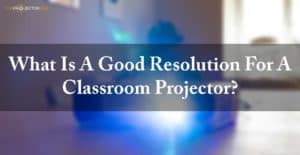 Classroom projectors are an important tool for educators, and they can be used to display images, videos, and other multimedia content.
Classroom projectors are an important tool for educators, and they can be used to display images, videos, and other multimedia content.
When choosing a projector for your classroom, it is important to consider the resolution. The resolution is the number of pixels that make up an image. The higher the resolution, the sharper the image will be. So what is a good resolution for a classroom projector?
In this post, we’ll explore What is a good resolution for a classroom projector for different classroom sizes and presentations. We’ll also discuss some other factors you’ll want to consider when purchasing a projector for your classroom.
What is a good resolution for a classroom projector?
How many types of projector resolution are there
There are many different types of projector resolution, which are often defined by how many pixels they contain. The most common resolution is 1080p, which is “1080 pixels per line.
This level of resolution allows you to watch a high-quality video with clear detail and no blurring. Other common resolutions include 4K, which is becoming increasingly popular for its ultra-high-definition capabilities, and 8K, the highest resolution available.
What is a good projector resolution for a classroom?
The ideal projector resolution for a classroom depends on the size of the room and the type of content that will be displayed. If you have ample space, it may be preferable to use a 4K resolution projector so that everyone can view the content clearly.
However, if your classroom is smaller, 1080p or 2K may be sufficient. You should also look for a projector with good color quality and brightness levels so that the images are visible even in well-lit rooms.
Before you select a projector for your classroom, think about these factors.
*side note: For classrooms, the optimal resolution is anything higher than 800 x 600.
Which throw ratio is best for a classroom projector?
One of the most important things to consider when looking for a classroom projector is the throw ratio. The throw ratio measures how far the projector can project an image at a given width.
There are three main types of throw ratio: ultra-short, short, and long (Details about throw ratio). The type of throw that is most appropriate for a classroom projector depends on the size of the classroom and the desired image size.
A projector with a short-throw ratio can project a large image from a short distance, while a projector with a long throw ratio will require a longer length to project the same image size.
The ideal throw ratio for a classroom projector is 1.5-2.0:1, which means that the projector can project a large image from a relatively short distance.
Another answer to this question is that if you’re going to be displaying the bulk of your content in standard definition a 4:3 projector may work best. If you will be displaying a mix of high definition and standard definition content, then it may be best to use a 16:9 projector.
How many lumens do I need for a classroom projector?
The brightness (Lumens) level is also an important consideration, especially in well-lit classrooms. The minimum brightness needed for a classroom projector will vary depending on the size of the room and the type of content being displayed.
If you are displaying text or other static images, you will need a minimum of 2,000 lumens. If you display video or other dynamic content, you will need at least 2,500 lumens. You generally want a projector with 2500-4000 lumens for the average classroom size.
Another thing to keep in mind is the type of bulbs used.
There are many types of bulbs: like UHP and halogen. UHP bulbs last much longer, but they cost more. Halogen bulbs don’t last as long but are cheaper.
Some projectors have an Eco mode, and this mode dims the projection slightly to save on bulb power. If you want to save money, a projector with Eco mode is a good choice.
Now that we’ve covered brightness basics let’s move on to contrast ratio. A projector’s contrast ratio is the difference in light intensity between the brightest white and the darkest black that the projector can produce.
A higher contrast ratio means that the projector can produce a wider range of shades, which results in a more detailed and realistic image. The ideal contrast ratio for a business projector is 1000:1, but you can get by with a lower ratio if you are on a budget.
What Resolution is Best for a classroom projector?
As with the brightness and contrast ratio, a resolution is one of the most important factors when searching for a projector. The higher the projector’s resolution, the sharper and clearer the image will be.
There are several different resolutions you may encounter when looking for a projector, including XGA, WXGA, and HD. Generally, if you want to ensure a high-quality resolution for your classroom projector, look for something with a resolution of at least 1920 x 1080 pixels.
2K or 4K resolution projectors are also available, but they tend to be more expensive. A 2K or 4K resolution projector can provide a truly exceptional viewing experience if your budget allows for it.
What ports do I need for a classroom projector?
When choosing a projector for your classroom, the number, and type of ports are important considerations. For example, if you want to connect your projector to a variety of devices, you’ll want to make sure that it has multiple ports.
Many projectors today have a variety of ports that you can use to connect to your computer, tablet, or other devices. Some standard ports on projectors include HDMI, VGA, and USB.
HDMI is one of the preferred connection points as it allows you to eliminate the chance of running into any issues such as jittering pixels stemming from poor signal sync.
A common input option is VGA (analog) which allows you to connect via computer and a composite video connection which allows you to connect video equipment.
A plus on a projector is Mobile High Definition Link-enabled HDMI, which allows you to show content from android devices (and charge them as well, in some cases).
How to Set Up PointWrite with PointWrite Pen and Touch Module

Conclusion Paragraph: What Is A Good Resolution For A Classroom Projector
The best resolution for a classroom projector depends on the size and brightness of the room. Several factors to consider, including durability, space savings, and wide-angle viewing.
Many education projectors offer filter-free design and extended lamp life, which can help schools stretch their technology budgets.
To find the right education projector for your school, assessing your room requirements and carefully considering the features outlined above is important. With the right projector in place, students will be able to learn and succeed for years to come.
